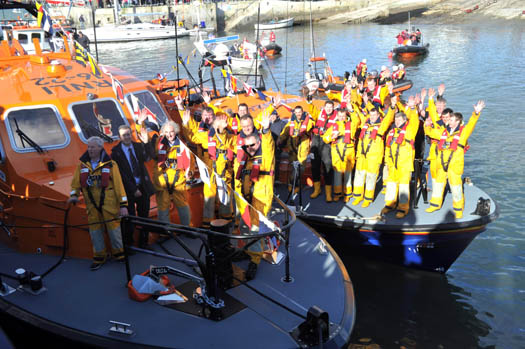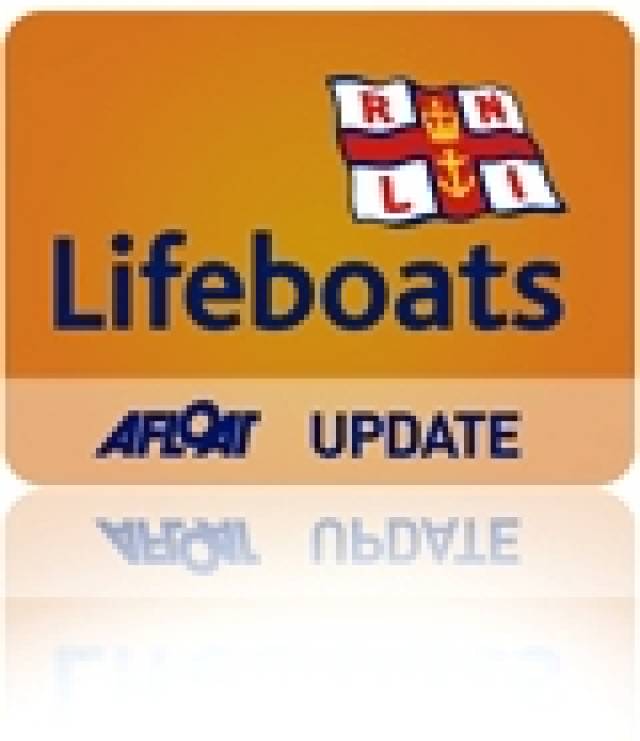#LIFEBOAT – The people of Baltimore welcomed a new addition to their community today when the RNLI delivered a €3 million Tamar class to the west Cork village. It is set to replace the Hilda Jarrett Tyne class lifeboat, which has served Baltimore since 1988. The new lifeboat left RNLI Headquarters in Poole last Saturday calling at a number of lifeboat stations along the way before undertaking the final leg of the journey this morning from Crosshaven to Baltimore Harbour.
Onboard the lifeboat was Baltimore RNLI crewmembers, Coxswain Keiron Cotter, mechanic Cathal Cottrell, Jerry Smith, Ronald Carthy and Patrick Collins along with RNLI Training Divisional Inspector Owen Medland and Deputy Divisional Engineer Michael Carmody. Ferry operators brought passengers out to escort the new lifeboat home and the harbour was full of local school children and residents.
The new lifeboat, which is named Alan Massey (ON 1302) was largely funded through a legacy from Mrs Dorothy May Massey from Watford in England, and has been named in memory of her late brother Alan, who it is understood had a love of the sea.
It was a proud day for Baltimore RNLI Coxswain Keiron Cotter who said, "We have been looking forward to this moment for a long time and we wish to acknowledge our volunteer lifeboat crew both past and present. The arrival of a new lifeboat to a station is an occasion of great pride and excitement. The Hilda Jarrett has served us well for over twenty years but as a Coxswain you look forward to receiving the newest lifeboat model with all the latest developments and technology onboard. We will spend the next month or so training all the volunteer lifeboat crew on her before we say goodbye to our Tyne class lifeboat, which will be returned to the relief fleet in Poole.

New home: The new Baltimore lifeboat passes 'The Beacon' on it's arrival escorted by Baltimore inshore lifeboat. Photo: Provision
We have so many memories onboard that old lifeboat, one of the highlights being the Rambler rescue last August. However along with the successful rescues there have also been tragedies and most recently we witnessed this with the search for the missing crewmen from the Tit Bonhomme in Glandore Harbour. Our thoughts are with their families today."

Crews celebrate the new lifeboat alongside in Baltimore harbour. Photo: Provision
The new Tamar class lifeboat is 16.3 metres in length with a maximum speed of 25 knots compared to the 14.3 metres of Baltimore RNLI's current Tyne class lifeboat which has a maximum speed of 18 knots. The lifeboat is self-righting in the event of a capsize and is fitted with an integrated electronics systems and information management system, which allows the lifeboat crew to monitor, operate and control many of the boats systems from shock mitigating seats.
The Tamar also carries a Y boat (an inflatable daughter boat) which is housed under the aft deck and deployed from a hinged door in the transom. The lifeboat has room for 44 survivors.
RNLI Training Divisional Inspector Owen Medland who made the journey with the lifeboat crew added, "I have been involved with this project for the last few years and today is a great day for everyone in Baltimore. This lifeboat represents a significant investment in safety along the west cork coastline. I wish the crew the very best and I know this lifeboat will go on to be a vessel that will save many lives and be a symbol of safety and protection for all those who venture out to sea."































































